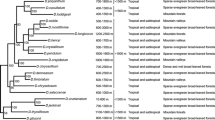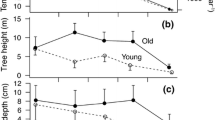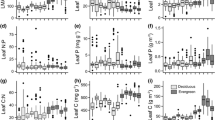Abstract
There is a spectrum from species with narrow, frequently branched twigs carrying small leaves and other appendages, to species with thick twigs carrying large leaves and appendages. Here we investigate the allometry of this spectrum and its relationship to two other important spectra of ecological variation between species, the seed mass—seed output spectrum and the specific leaf area—leaf lifespan spectrum. Our main dataset covered 33 woody dicotyledonous species in sclerophyll fire-prone vegetation on low nutrient soil at 1,200 mm annual rainfall near Sydney, Australia. These were phylogenetically selected to contribute 32 evolutionary divergences. Two smaller datasets, from 390 mm annual rainfall, were also examined to assess generality of cross-species patterns. There was two to three orders of magnitude variation in twig cross-sectional area, individual leaf size and total leaf area supported on a twig across the study species. As expected, species with thicker twigs had larger leaves and branched less often than species with thin twigs. Total leaf area supported on a twig was mainly driven by leaf size rather than by the number of leaves. Total leaf area was strongly correlated with twig cross-section area, both across present-day species and across evolutionary divergences. The common log-log slope of 1.45 was significantly steeper than 1. Thus on average, species with tenfold larger leaves supported about threefold more leaf area per twig cross-section, which must have considerable implications for other aspects of water relations. Species at the low rainfall site on loamy sand supported about half as much leaf area, at a given twig cross-section, as species at the low rainfall site on light clay, or at the high rainfall site. Within sites, leaf and twig size were positively correlated with seed mass, and negatively correlated with specific leaf area. Identifying and understanding leading spectra of ecological variation among species is an important challenge for plant ecology. The seed mass—seed output and specific leaf area—leaf lifespan spectra are each underpinned by a single, comprehensible trade-off and their consequences are fairly well understood. The leaf-size-twig-size spectrum has obvious consequences for the texture of canopies, but we are only just beginning to understand the costs and benefits of large versus small leaf and twig size.




Similar content being viewed by others
References
Ackerly DD, Donoghue MJ (1998) Leaf size, sapling allometry, and Corner's Rules—phylogeny and correlated evolution in maples (Acer). Am Nat 152:767–791
Ackerly DD, Reich PB (1999) Convergence and correlations among leaf size and function in seed plants: A comparative test using independent contrasts. Am J Bot 86:1272–1281
Bond WJ (1989) The tortoise and the hare: ecology of angiosperm dominance and gymnosperm persistence. Biol J Linn Soc 36:227–249
Brouat C, Gibernau M, Amsellem L, McKey D (1998) Corners rules revisited—ontogenetic and interspecific patterns in leaf-stem allometry. New Phytol 139:459–470
Cornelissen JHC (1999) A triangular relationship between leaf size and seed size among woody species: allometry, ontogeny, ecology and taxonomy. Oecologia 118:248–255
Corner E (1949) The durian theory, or the origin of the modern tree. Ann Bot 13:368–414
Edwards WRN, Jarvis PG (1982) Relations between water content, potential and permeability in stems of conifers. Plant Cell Environ 5:271–277
Fonseca CR, Overton JM, Collins B, Westoby M (2000) Shifts in trait combinations along rainfall and phosphorus gradients. J Ecol 88:964-977
Grace J (1997) Plant water relations. In: Crawley M (ed) Plant ecology, 2nd edn. Blackwell, Oxford, pp 28–50
Grubb PJ (1998) A reassessment of the strategies of plants which cope with shortages of resources. Perspect Plant Ecol Evol Syst 1:3–31
Halle F, Oldeman RAA, Tomlinson PB (1978) Tropical trees and forests. An architectural analysis. Springer, Berlin Heidelberg New York
Harvey PH, Read AF, Nee S (1995a) Further remarks on the role of phylogeny in comparative ecology. J Ecol 83:733–734
Harvey PH, Read AF, Nee S (1995b) Why ecologists need to be phylogenetically challenged. J Ecol 83:535–536
Henery ML, Westoby M (2001) Seed mass and seed nutrient content as predictors of seed output variation between species. Oikos 92:479–490
Leishman MR, Westoby M, Jurado E (1995) Correlates of seed size variation: a comparison among five temperate floras. J Ecol 83:517–530
Leishman MR, Wright IJ, Moles AT, Westoby M (2000) The evolutionary ecology of seed size. In: Fenner M (ed) Seeds: the ecology of regeneration in plant communities, 2nd edn. CAB International, Wallingford, UK, pp 31–57
Marañón T, Grubb PJ (1993) Physiological basis and ecological significance of the seed size and relative growth rate relationship in Mediterranean annuals. Funct Ecol 7:591–599
Mencuccini M, Grace J (1995) Climate influences the leaf area/sapwood area ratio in Scots pine. Tree Physiol 15:1–10
Niinemets U (1996) Plant growth-form alters the relationship between foliar morphology and species shade-tolerance ranking in temperate woody taxa. Vegetatio 124:145–153
Niinemets U (1998) Are compound-leaved woody species inherently shade-intolerant—an analysis of species ecological requirements and foliar support costs. Plant Ecol 134:1–11
Niinemets U, Kull K (1994) Leaf weight per area and leaf size of 85 Estonian woody species in relation to shade tolerance and light availability. For Ecol Manage 70:1–10
Niklas K (1992) Plant biomechanics: An engineering approach to plant form and function. The University of Chicago Press, Chicago
Pitman ETG (1939) A note on normal correlation. Biometrika 31:9–12
Reich PB, Walters MB, Ellsworth DS (1997) From tropics to tundra: global convergence in plant functioning. Proc Natl Acad Sci USA 94:13730–13734
Reich PB et al. (1999) Generality of leaf trait relationships: a test across six biomes. Ecology 80:1955–1969
Shipley B (1995) Structured interspecific determinants of specific leaf area in 34 species of herbaceous angiosperms. Funct Ecol 9:312–319
Sokal RR, Rohlf FJ (1995) Biometry: the principles and practice of statistics in biological research, 3rd edn. Freeman, New York
Warton DI, Weber NC (2002) Common slope tests for bivariate errors-in-variables models. Biom J 44:161–174
Westoby M (1998) A leaf-height-seed (LHS) plant ecology strategy scheme. Plant Soil 199:213–227
Westoby M (1999) Generalization in functional plant ecology: the species sampling problem, plant ecology strategies schemes, and phylogeny. In: Pugnaire FI, Valladares F (eds) Handbook of functional plant ecology. Dekker, New York, pp 847–872
Westoby M, Rice B, Howell J (1990) Seed size and plant growth form as factors in dispersal spectra. Ecology 71:1307–1315
Westoby M, Leishman M, Lord JM (1995a) Further remarks on phylogenetic correction. J Ecol 83:727–734
Westoby M, Leishman MR, Lord JM (1995b) Issues of interpretation after relating comparative datasets to phylogeny. J Ecol 83:892–893
Westoby M, Leishman MR, Lord JM (1995c) On misinterpreting the 'phylogenetic correction'. J Ecol 83:531–534
Westoby M, Leishman M, Lord J (1996) Comparative ecology of seed size and dispersal. Philos Trans R Soc Lond Ser B 351:1309–1318
Westoby M, Warton D, Reich PB (2000) The time value of leaf area. Am Nat 155:649–656
Westoby M, Falster DS, Moles AT, Vesk PA, Wright IJ (2002) Plant ecological strategies: some leading dimensions of variation between species. Annu Rev Ecol Syst 33:125–159
White P (1983a) Evidence that temperate east north American evergreen woody plants follow Corner's Rules. New Phytol 95:139–145
White PS (1983b) Corner's rules in eastern deciduous trees: allometry and its implications for the adaptive architecture of trees. Bull Torrey Bot Club 110:203–212
Whitehead D, Edwards W, Jarvis P (1984a) Conducting sapwood area, foliage area, and permeability in mature trees of Picea sitchensis and Pinus contorta. Can J For Res 14:940–947
Whitehead D, Jarvis P, Waring R (1984b) Stomatal conductance, transpiration and resistance to water uptake in a Pinus sylvestris spacing experiment. Can J For Res 14:692–700
Wright IJ, Reich PB, Westoby M (2001) Strategy-shifts in leaf physiology, structure and nutrient content between species of high and low rainfall, and high and low nutrient habitats. Funct Ecol 15:423–434
Acknowledgements
Warm thanks to students in Biol368 Ecology and Evolution 1999 for their efforts, to Kathy Cannon for much organization and technical help, to David Duncan, Angela Moles, Cassia Read, Barbara Rice and Peter Vesk for help with field work in inland NSW, and to Angela Moles and Christian Körner for helpful comments on the manuscript. The New South Wales National Parks and Wildlife Service gave permission to work in Ku-Ring-Gai Chase National Park and Round Hill Nature Reserve. Contribution number 382 from the Research Unit for Biodiversity and Bioresources, Macquarie University.
Author information
Authors and Affiliations
Corresponding author
Rights and permissions
About this article
Cite this article
Westoby, M., Wright, I.J. The leaf size – twig size spectrum and its relationship to other important spectra of variation among species. Oecologia 135, 621–628 (2003). https://doi.org/10.1007/s00442-003-1231-6
Received:
Accepted:
Published:
Issue Date:
DOI: https://doi.org/10.1007/s00442-003-1231-6




